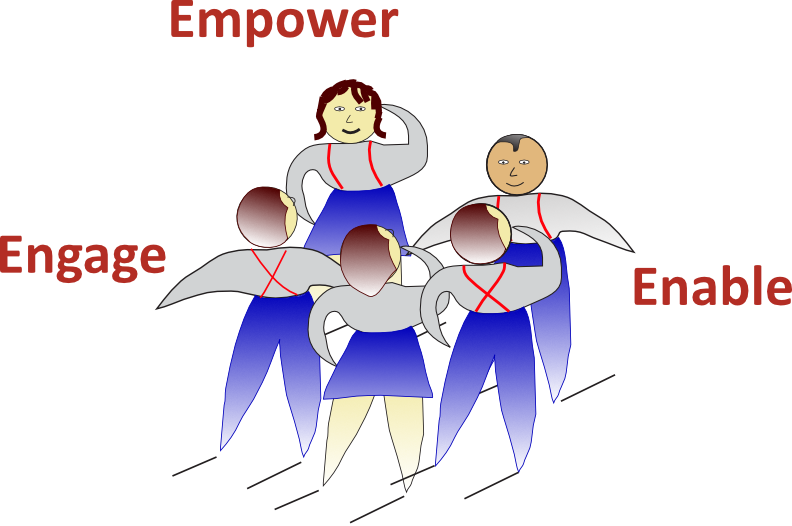
In this series, I’ll share "snippets" of topics related to facilitation, facilitating, meetings, and my FoCuSeD™ Facilitator training.
by Gary Rush, IAF CPF | Master
"Neutrality" How Does it Fit? Why it Matters...
A Facilitator 'IS' the Ultimate 'Servant Leader'
The Generic Nature of the Word 'Facilitator' vs 'Group Facilitator'
Teambuilding is not an "exercise"
"Neutrality" How does it Fit? Why it Matters…
Warning: You cannot lead as a neutral Facilitator when you give your input influencing the group, and then move on as if nothing happened, the Participants trust in you will diminish.
“Neutrality”
Every facilitated workshop or group meeting includes two elements that are distinct and work together:
- The ‘subject matter’ – what the workshop or meeting is about.
- The ‘agenda and process behind the agenda’ – what enables you to get a group of people to come together and focus their discussion to accomplish their task.
Remaining Neutral means ‘managing the agenda and process’ and you not getting involved in the subject matter. Neutrality is about believing in the power and value of the group. You must believe that a group can make valid decisions and you must, therefore, remain neutral to build trust and engagement.
How does it Fit?
When I’m “Facilitating”, I set the expectation with the group that I will remain neutral. Setting the expectation at the start enables the group to know how I will conduct myself – it builds trust in the process. Neutrality is a core competency of a Facilitator so that we don’t influence the group and/or subject matter. It also means that successful Facilitators need not know about the 'subject matter', that is left to the subject matter experts (SMEs) participating.
When I “lead” a meeting, I find that remaining neutral adds value because if I both set the agenda and I add input to the subject matter, the group will sit back allowing me to do most of the work. If I set the agenda and remain neutral, I find the group to be more engaged, supporting the outcome because it is their input.
Why it Matters…
Remaining neutral does not mean that you become passive; it simply means that you focus on the process.
For example, when developing a plan, an objective must be Specific, Measurable, Achievable, Relevant, and Time-based (SMART) to be an objective. As Facilitator, I ensure that the group defines their objectives so that each is SMART, but I don’t influence them as to whether they go after 25% or 35% of something.
SMART is process. 25% or 35% is subject matter.
So, in closing, I say…
To remain neutral, you must be able to separate the process from the subject matter... ![]()
A Facilitator ‘IS’ the Ultimate ‘Servant Leader’
Servant Leader – leadership that is crucial to being able to form a group into a team to come together to reach their objectives.
A Servant Leader requires applying facilitation skills learned to engage all making them feel that they are part of a greater whole, and decisions made have their involvement. So how do we move from command-and-control? We empower the group. We avoid influencing with our views so that the group doesn’t acquiesce to our point of view without voicing their own. Then:
- Engage – Ask the group to present their views. Listen to them and make it safe for all to contribute. Post their views and frequently summarize what was said, use Active Listening. This is Divergence – gaining all perspectives. Safe Divergence helps build trust.
- Enable – Provide a thought process for understanding. Follow a well-defined thought process that enables reflection, enriching, and challenging views. This is Struggle – understanding all perspectives and points of view. Safe Struggle helps build healthy conflict and trust.
- Converge – Complete the cycle. After all views have been discussed and it appears that the group is heading towards alignment or consensus, summarize what was said. This is Convergence – coming together to find a solution everyone can support. Safe Convergence enables teamwork to move forward.
Does it work…
- Do we give up control? If you define “control” as your way, then you will be dismayed. By engaging all, not only do you develop more suitable views, but commitment will vastly increase.
- Does it take a long time? I’ve read books and listened to others complain that reaching consensus is more time-consuming than having one person decide – command and control style. This is a narrow view. We accomplish far more in a shorter amount of time by using a Servant Leader A well-thought-out decision with support and commitment requires teamwork – engagement is key.
Therefore…
A Servant Leader is far more effective when he or she empowers, engages, and enables the group to transcend the sum of the parts.
A Facilitator ‘IS’ the Ultimate ‘Servant Leader’… ![]()
The Generic Nature of the Word ‘Facilitator’ vs ‘Group Facilitator’
Today, I hear the word ‘Facilitator’ used in other roles and it confuses clients and others who mistake what I do.
What is a ‘Facilitator’?
The dictionary provides a broad definition, which does not answer the question nor differentiate the role. Facilitate is defined as to make easier, and a Facilitator is defined as one who makes easier. No help.
- Holywood doesn’t help either. In the movie Erasure, James Caan respond to Arnold Schwarzenegger that he was the “facilitator”, in this case, the hit man.
- Members of the Association for Training and Development (ATD) call themselves I prefer ‘Teachers’ – an honorable role.
- I listened to a manager from Disney World say that all employees were ‘facilitators’ because they facilitate the visit to Disney World.
International Association of Facilitators (IAF)
The IAF defines an IAF Certified™ Professional Facilitator (IAF CPF) as a “credentialed Facilitator who has demonstrated evidence of meeting the IAF Core Facilitator Competencies” (competencies that describe an effective group facilitator), but the IAF does not define ‘Facilitator’.
- As an IAF CPF Assessor, I still see applications from those who want to become an IAF CPF describing some of their required workshops as “facilitating a class”. The IAF CPF is looking for ‘facilitated workshops’.
The word ‘facilitator’ has been diluted, so much, that it’s applied to many roles confusing what a ‘Facilitator’ really means.
So, Let’s Change from Facilitator to ‘Group Facilitator’
I define Group Facilitator as:
“A content neutral person who guides the ‘group’ to consensus using effective processes to enable the ‘group’ to make effective decisions while supporting a collaborative and respectful environment that encourages ‘group’ participation and helps the ‘group’ overcome barriers to accomplish their objectives.”
Looking at what we do, we ‘guide the group’ therefore, we are “Group Facilitators”. This adds specificity, and the definition is clear. ![]()
“Let’s do this…”
‘How to’ Build Trust…
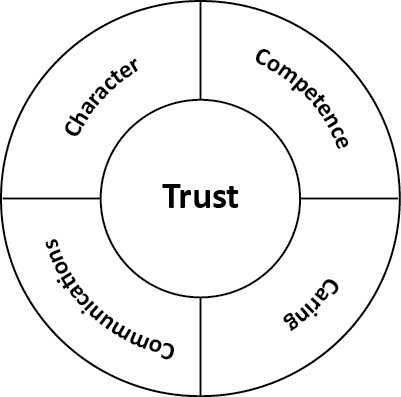
Building trust is the first step towards building a team…
A key element in building a team is building trust amongst the members of the group. Trust is seldom built in games – e.g., some have taken participants to rope courses and the participants are to ensure that others don’t get hurt, claiming that action helps build trust. Building Trust is far more complex than that.
There are four components to Trust. We trust someone because:
- Character – We are comfortable with his or her character.
- Competence – We view his or her competence as good or better.
- Caring – We believe that he or she cares as much as we do.
- Communication – We communicate well.
When we don’t trust, it is because we believe that there are flaws in one or more of the above components.
How to Build Trust…
Simple activities don’t enable building trust (I’m not talking about trusting someone with your life, I’m talking about trusting someone in what you do). People must work together to accomplish something. It’s the joint accomplishment that enables them to address the four components to build trust. Therefore, ‘building trust’ requires engaging in constructive dialog to understand which component(s) are viewed as flawed and working to change that perception by correcting the flaw and/or developing understanding. ![]()
Teambuilding is not an “exercise”
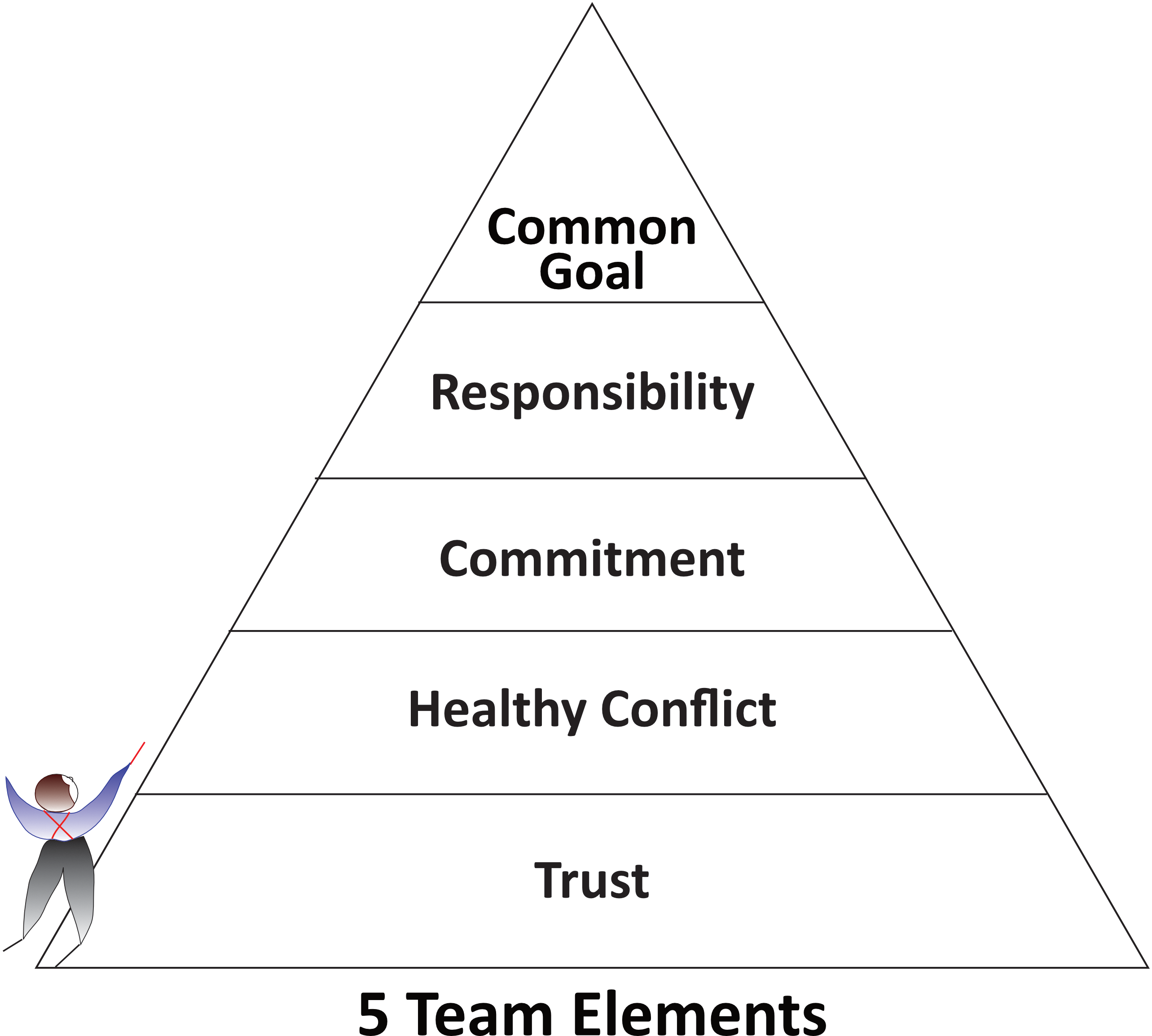 Teambuilding is taking the right action to address the right problem, and there is no “one size fits all”. To be successful, you assess the group, select the right action moving them towards teamwork. It is continuous because teams change all the time.
Teambuilding is taking the right action to address the right problem, and there is no “one size fits all”. To be successful, you assess the group, select the right action moving them towards teamwork. It is continuous because teams change all the time.
Building a team is addressing weaknesses in the 5 team elements, ensuring the team exists in a constructive environment. All 5 team elements work together, beginning with Trust and working towards a Common Goal.
A Group becomes a Team when they…
- Trust in each other – A critical team element. It enables the remaining 4 team elements to work (see my previous Snippet, “How to Build Trust”).
- Engage in Healthy Conflict – When people trust, they feel comfortable to disagree. If all members of a team are thinking alike, no one is thinking.
- Make Commitments – When people engages in healthy conflict, they will reach Consensus. Once consensus is reached, Commitment
- Take Responsibility – When a team commits, they take on Responsibility. Responsibility means that they are held accountable for their commitments.
- Pursue a Common Goal – A team comes together when it aims for a Common Goal.
‘How to’ Build a Team…
Building a team is more than conducting an exercise or two. Building a team requires assessing the team and matching appropriate actions moving them towards teamwork…
- If the weakness is a Common Goal, use ‘strategic thinking’. Work with the team to develop a common vision – a target of what they want to accomplish. Also, develop a common mission – a reason for their existence.
- If the weakness is Responsibility, develop a core set of team values – what they believe in. This builds integrity.
- If the weakness is Commitment, work to reach consensus developing commitment.
- If the weakness is Healthy Conflict, use probing questions. If someone disagrees, probe to ensure he or she speaks up. Understand ‘how to’ Manage Conflict.
- If the weakness is Trust, get the team to openly talk to each other (see my previous Snippet, “How to Build Trust”).
Teambuilding is taking the right action to address the right problem. ![]()
Creativity Skills
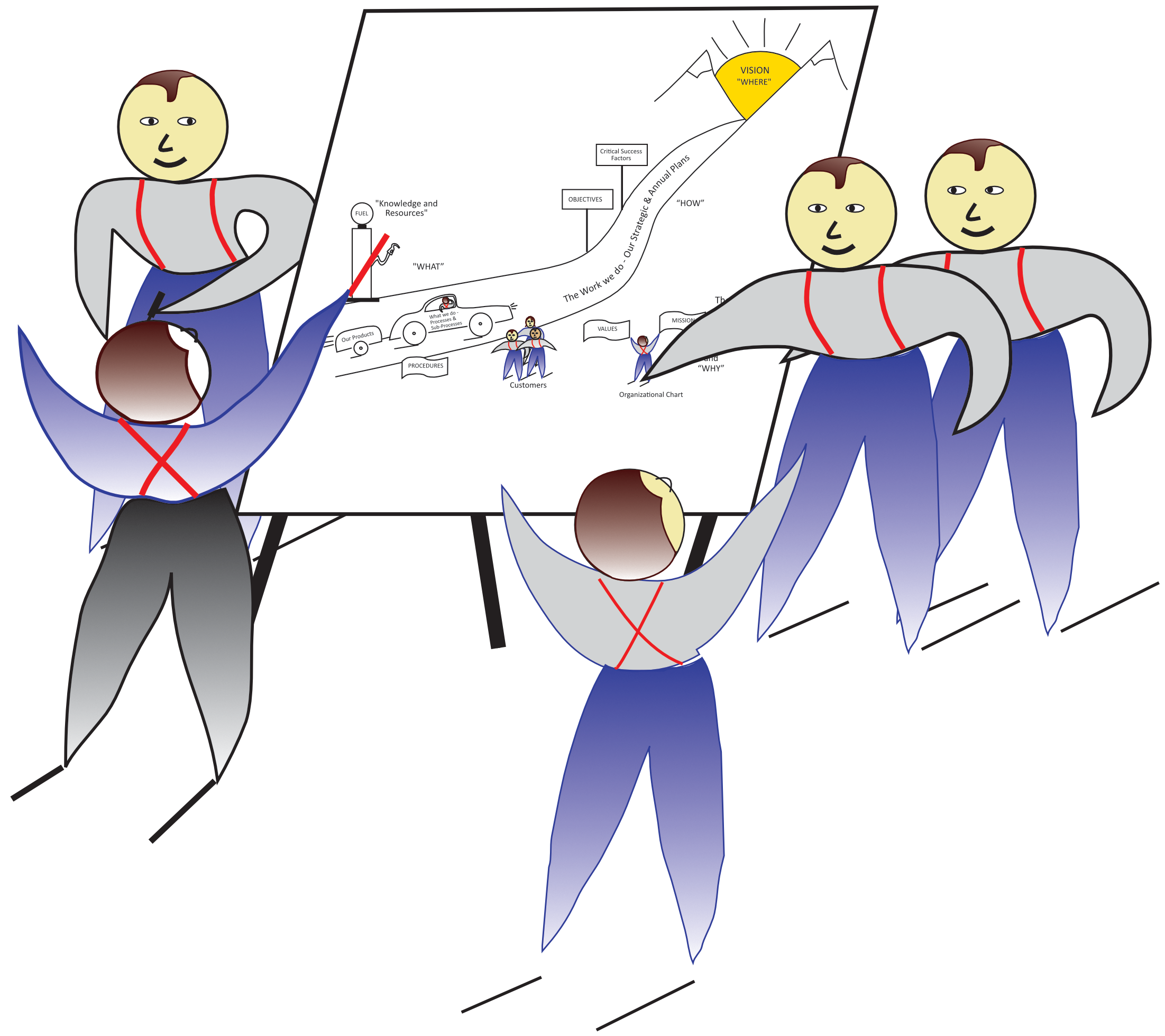 Creativity is the engine of innovation. Creativity is generating something new, surprising, unusual, novel, or original that is useful and meaningful. It is guided through discovery and process once you understand the necessary skills required…
Creativity is the engine of innovation. Creativity is generating something new, surprising, unusual, novel, or original that is useful and meaningful. It is guided through discovery and process once you understand the necessary skills required…
Fluency – Lots of ideas
Fluency is what Alex Osborn developed with brainstorming. Clearly separate ideation (the formation of ideas) from evaluation (analyzing the ideas). The trick is to define and enforce rules of ideation that encourage fluency. Fluency requires P.T.S/P.T.F. (Permission to Suck / Permission to Fail). Organizations should adopt the concept that all ideas are required – the good, the bad, and the ugly and that people require permission to fail.
“I have not failed. I’ve just found 10,000 ways that won’t work.” – Thomas Edison.
Flexibility – unique ideas
Repeating the same idea, with only slight differences, does not help creativity. Use visual aids and constraints that help creativity.
Originality – unusual ideas
In generating ideas, use tools to help stimulate new ideas. Use tools that help synthesize similar or related ideas into one unique idea. Also, questions, such as, “Why not…?” help in assessing ideas without dismissing those that are unique and original.
Elaboration – presenting ideas
Ideas are useless unless you can implement them. Questions, such as, “Why not…?” and “What if…?” help get people to fully describe their ideas and flush out gaps and inconsistencies. People need to be able to take an idea and turn it into an actionable solution.
Conclusion
Creativity is important and requires facilitation skills. I teach you ‘how to’ enable team creativity in my 4-day FoCuSeD™ Facilitator Academy class. Thank you…
“If everybody is thinking the same thing, nobody is thinking.” – General George Patton ![]()
Transformational Change
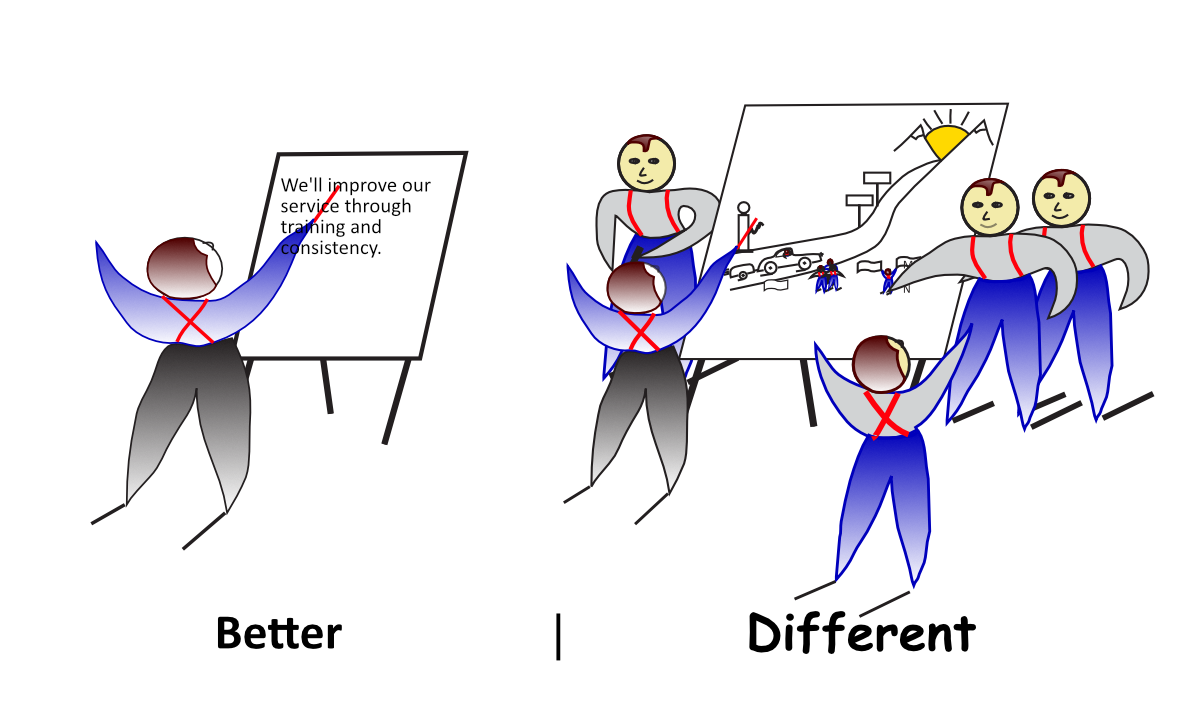 When we facilitate, one goal is to enable a group to achieve success, which brings Transformational Change. This is defined as:
When we facilitate, one goal is to enable a group to achieve success, which brings Transformational Change. This is defined as:
Quality of the Solution times the Engagement and Commitment of the People.
As Facilitators, we establish the process to ensure a quality solution through engagement of the group. Some things to think about when you facilitate:
- Are you enabling the group work towards a solution that is better (slight improvement) or different (transformational)?
- Are the questions asked driving or stifling innovation?
Better | Different
Sometimes groups take the path of least resistance. They may recognize that there is a need for change but, to keep it safe, they jump to solutions that sound better, but are they different? Let’s look at the following:
Example: Which restaurant do you think makes more of an impact on its customers?
There are two fine dining restaurants in the same vicinity – both cuisines are excellent. They are both trying to increase customer loyalty. They both realize that service is the differentiating factor.
Restaurant A decides to make their service ‘better’. They make it crisper, ensure that all wait staff smiles, timing is perfect, and that customers feel well served.
Restaurant B decides to make their service ‘different’. They change the wait staff outfits to match the restaurant theme; they script the wording so that service is delivered with poetic phrases; they make service more of an event.
Facilitators need to question the group to help them recognize and then decide whether it’s better or different.
Innovation Questions without Violating Neutrality
The following are innovation questions that will help groups explore their creativity to enable conscious decisions.
- Why? Why Not?
- Yes, and… Yes, but…
- What if…?
Creativity is the Engine of Innovation
Creativity enables generating something new, surprising, unusual, novel, original, that solves the problem. Creativity can be introduced to groups through process and exercises. ![]()
Managing Conflict
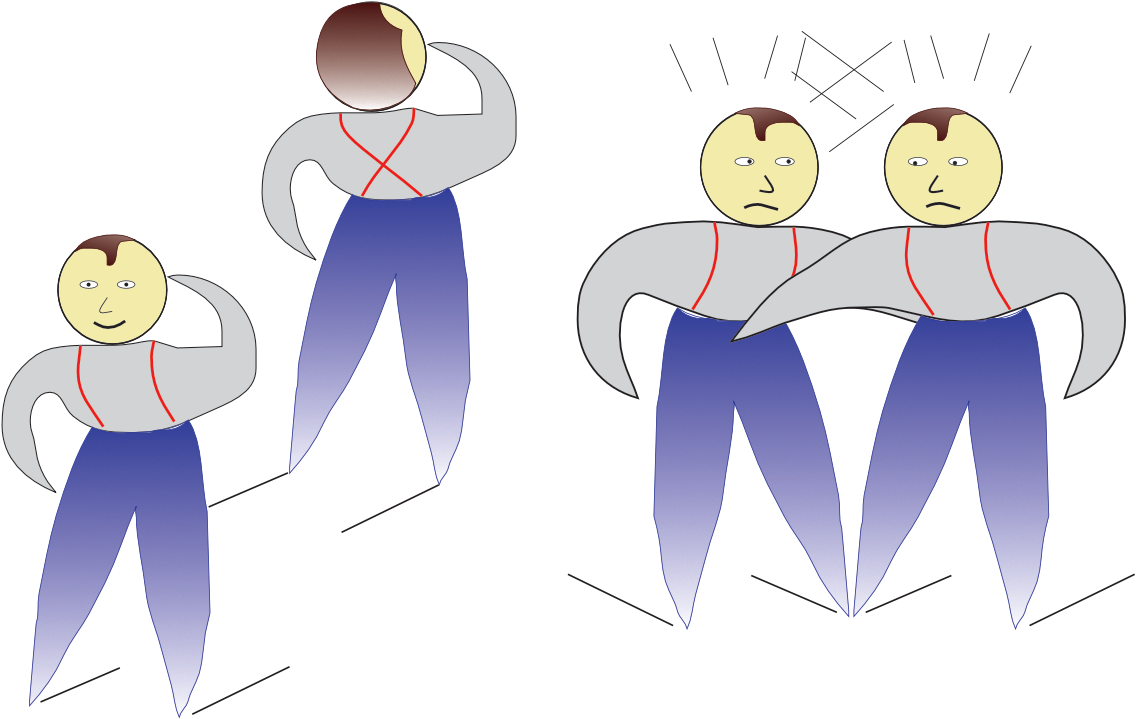 Conflict in a group is natural. Leaders, facilitators, managers, must learn ‘how to’ manage conflict. When managed effectively, conflict becomes productive. Conflict gives rise to expanded information exchange, more options, surfaced rationales, and effective group decisions that enable change. When managed poorly, conflict leads to downturns in productivity. The dominant motive involved is control. To effectively manage conflict, we must first understand it. Do you see conflict as:
Conflict in a group is natural. Leaders, facilitators, managers, must learn ‘how to’ manage conflict. When managed effectively, conflict becomes productive. Conflict gives rise to expanded information exchange, more options, surfaced rationales, and effective group decisions that enable change. When managed poorly, conflict leads to downturns in productivity. The dominant motive involved is control. To effectively manage conflict, we must first understand it. Do you see conflict as:
- A battle to be won or a problem to be solved?
- Inevitable or preventable?
- Constructive or destructive?
Society places negative values on conflict at home, at school, and at work. Think about the first words or images that come to mind whenever you hear the word “conflict.” Are they positive or are they negative? We are not taught collaborative problem-solving skills and generally try to solve conflict by winning. Conflict is a source of energy – a change agent if properly channeled. Without conflict, no progress is made. Simply hearing, “I don’t agree.” or, “Let’s try something different.” is a sign of conflict. Conflict can appear as subtle comments or not so subtle actions.
Think about your perception of conflict and work to make it productive. Use active listening skills to help those in conflict hear what they are saying and begin to hear what others are saying. Understand how you respond to conflict. To effectively facilitate, you must keep conflict constructive and . . .
- Actively Listen – help all involved hear themselves and each other.
- Know ‘how to’ communicate acceptance – use it to allow communication.
- Understand social identities – learn how our identities affect conflict.
- Learn how to effectively confront – address the problem situation with diplomacy.
- Understand anger – yours and theirs.
- Understand consensus (“win-win”) – do not look for compromise (“lose-lose”).
- Properly prepare – know that it’s unavoidable so you have a plan to handle it.
- Build a ‘tool kit’ – tools and exercises to build teams and diffuse problems.
Summary
When managed properly, conflict provides opportunities for creative energy and new ideas.
- Do not fear conflict, be concerned about poorly handled conflict. Managing conflict requires that you understand it.
- Identify the source of the conflict. Look for the barriers and plan ‘how to’ overcome the barriers.
- Active listening is the most effective tool in managing conflict and turning it into something productive.
- Realize that we are all different and our identities affect our ability to deal with other’s conflict – either because our identity is part of the conflict, or it affects the way we see the conflict.
- Confront conflict early on and plan ‘how to’ confront it. Poor confrontation or avoidance only makes the situation worse.
- Understand anger and allow it to diffuse so that you can get to the source of the conflict without creating hostility.
Why? Challenges our Paradigms
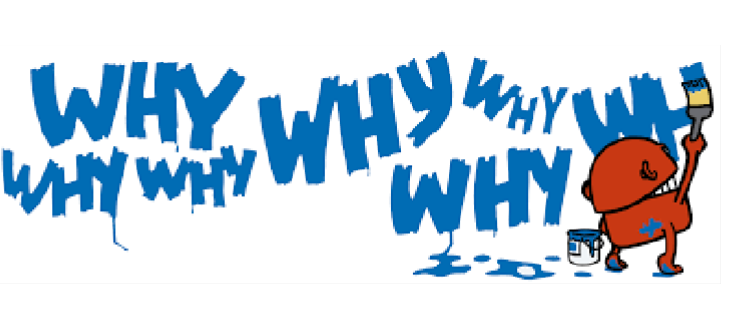 Arguably the most important question asked is, “Why?” “Why?” is part of our DNA, it challenges our paradigms. Simon Sinek describes how Steven Jobs begins presentations with “why” to increase impact and acceptance.
Arguably the most important question asked is, “Why?” “Why?” is part of our DNA, it challenges our paradigms. Simon Sinek describes how Steven Jobs begins presentations with “why” to increase impact and acceptance.
Why is “Why?” so Important?
When people get together, they do so for a reason, the reason describes the “purpose” statement. Without the purpose, there is no reason.
When I train “how to” effectively facilitate meetings / workshops, I insist on a purpose statement for every step in the agenda so when asked, “why?” there is a legitimate response – purpose. Without a legitimate purpose, it will be difficult to guide the group.
The same is true when defining processes, data, organizations, building computer systems, buying software, etc. Without the “why”, decisions, selections, and actions serve no purpose. It must be the first question asked in any effort. “Why are we buying this software?” “Why do you need this data?” “Why does this process exist?”.
So, begin by asking, “Why?” When we ask “Why?”, we start our efforts with a common purpose.
I teach you ‘how to’ enable all of the Snippet topics in my 4-day FoCuSeD™ Facilitator Academy class.
Stay tuned for my next "snippet" - "Why, What, When, Who, How, and Where?"

